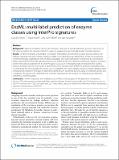Files in this item
EnzML : multi-label prediction of enzyme classes using InterPro signatures
Item metadata
| dc.contributor.author | De Ferrari, Luna | |
| dc.contributor.author | Aitken, Stuart | |
| dc.contributor.author | van Hemert, Jano | |
| dc.contributor.author | Goryanin, Igor | |
| dc.date.accessioned | 2014-01-13T13:01:04Z | |
| dc.date.available | 2014-01-13T13:01:04Z | |
| dc.date.issued | 2012-04 | |
| dc.identifier | 35085614 | |
| dc.identifier | 2a87b079-caa1-4a01-b6df-0624708ed880 | |
| dc.identifier | 000308067200001 | |
| dc.identifier | 84860154266 | |
| dc.identifier.citation | De Ferrari , L , Aitken , S , van Hemert , J & Goryanin , I 2012 , ' EnzML : multi-label prediction of enzyme classes using InterPro signatures ' , BMC Bioinformatics , vol. 13 , 61 . https://doi.org/10.1186/1471-2105-13-61 | en |
| dc.identifier.issn | 1471-2105 | |
| dc.identifier.uri | https://hdl.handle.net/10023/4361 | |
| dc.description | LDF is funded by ONDEX DTG, BBSRC TPS Grant BB/F529038/1 of the Centre for Systems Biology at Edinburgh and the University of Newcastle. SA is supported by by a Wellcome Trust Value In People award and, together with IG, the Centre for Systems Biology at Edinburgh, a centre funded by the Biotechnology and Biological Sciences Research Council and the Engineering and Physical Sciences Research Council (BB/D019621/1). JVH was funded by various BBSRC and EPSRC grant | en |
| dc.description.abstract | Background: Manual annotation of enzymatic functions cannot keep up with automatic genome sequencing. In this work we explore the capacity of InterPro sequence signatures to automatically predict enzymatic function. Results: We present EnzML, a multi-label classification method that can efficiently account also for proteins with multiple enzymatic functions: 50,000 in UniProt. EnzML was evaluated using a standard set of 300,747 proteins for which the manually curated Swiss-Prot and KEGG databases have agreeing Enzyme Commission (EC) annotations. EnzML achieved more than 98% subset accuracy (exact match of all correct Enzyme Commission classes of a protein) for the entire dataset and between 87 and 97% subset accuracy in reannotating eight entire proteomes: human, mouse, rat, mouse-ear cress, fruit fly, the S. pombe yeast, the E. coli bacterium and the M. jannaschii archaebacterium. To understand the role played by the dataset size, we compared the cross-evaluation results of smaller datasets, either constructed at random or from specific taxonomic domains such as archaea, bacteria, fungi, invertebrates, plants and vertebrates. The results were confirmed even when the redundancy in the dataset was reduced using UniRef100, UniRef90 or UniRef50 clusters. Conclusions: InterPro signatures are a compact and powerful attribute space for the prediction of enzymatic function. This representation makes multi-label machine learning feasible in reasonable time (30 minutes to train on 300,747 instances with 10,852 attributes and 2,201 class values) using the Mulan Binary Relevance Nearest Neighbours algorithm implementation (BR-kNN). | |
| dc.format.extent | 12 | |
| dc.format.extent | 1100222 | |
| dc.language.iso | eng | |
| dc.relation.ispartof | BMC Bioinformatics | en |
| dc.subject | Enzymatic function | en |
| dc.subject | Automatic genome sequencing | en |
| dc.subject | InterPro signatures | en |
| dc.subject | EnzML | en |
| dc.subject | QA75 Electronic computers. Computer science | en |
| dc.subject | QH301 Biology | en |
| dc.subject.lcc | QA75 | en |
| dc.subject.lcc | QH301 | en |
| dc.title | EnzML : multi-label prediction of enzyme classes using InterPro signatures | en |
| dc.type | Journal article | en |
| dc.contributor.institution | University of St Andrews. School of Chemistry | en |
| dc.identifier.doi | 10.1186/1471-2105-13-61 | |
| dc.description.status | Peer reviewed | en |
This item appears in the following Collection(s)
Items in the St Andrews Research Repository are protected by copyright, with all rights reserved, unless otherwise indicated.

